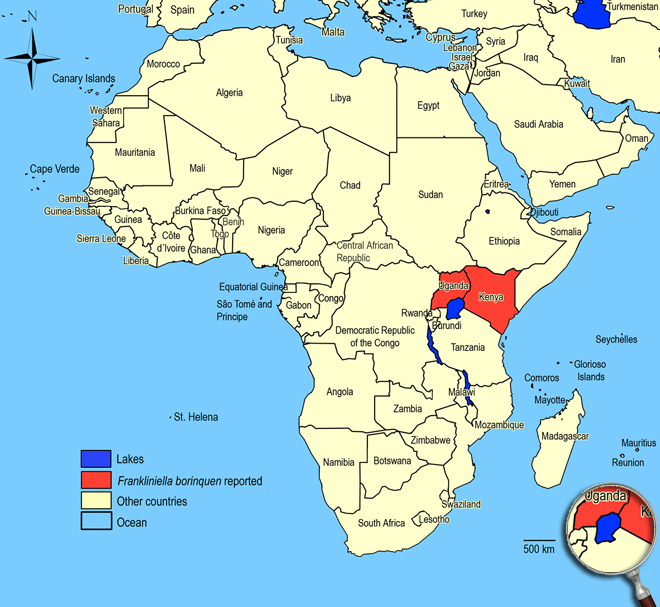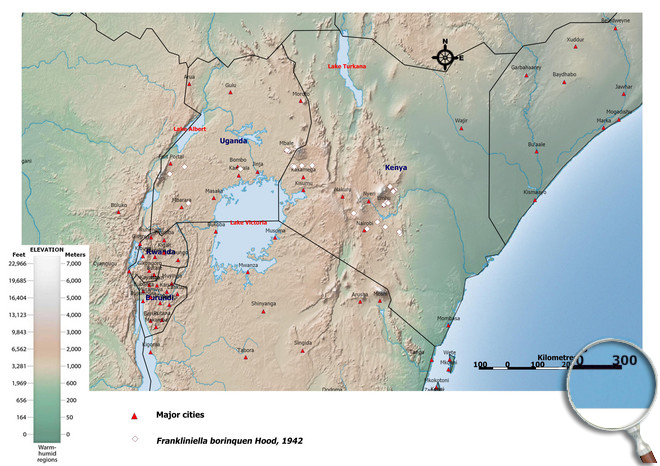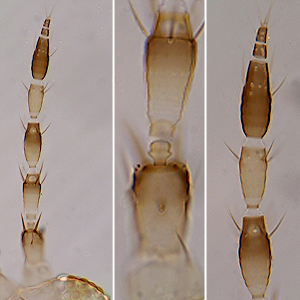Frankliniella borinquen Hood, 1942
Thripinae, Thripidae, Terebrantia, Thysanoptera
Figures
Fig. 1: Antenna, scape, pedicel and first segment of flagellum, segments IV-VIII
Fig. 2: Special shape of pedicel
Fig. 3: Head dorsal with ocellar triangle
Fig. 4: Pronotum
Fig. 5: Metanotum
Fig. 6: Forewing, mid and distal region
Fig. 7:
Sternites IV and V
Fig. 8: Tergite VIII
Fig. 9: Adult female
Introduction and recognition
Frankliniella borinquen breeds on a wide range of plants e.g. beans and cruciferous plants. In Kenya and Uganda, this species is very closely associated with Tithonia diversifolia. Both sexes fully winged. Body color nearly uniformly pale yellow, deepest in pterothorax; legs paler than body; major setae dark brown; antennal segments I & II whitish yellow, III & IV pale yellow basally and brown apically, V pale with faint shades at base and at tip, VI yellowish brown at base otherwise like VII & VIII brown; fore wings pale (Fig. 9). Antennae 8-segmented; segments III & IV with forked sense cone, segment III pedicel distal to basal ring with a convex swelling and ill-defined collar, segment VIII equal in length to or less shorter than segment VII (Fig. 1). The pedicel between the II and III antennal segment is swollen, with edged ring surmounted by a distinctive swelling and a slightly flared collar (cup and saucer shaped) (Fig. 1, 2). Head wider than long; 3 pairs of ocellar setae present, pair III about as long as distance between the midpoints of hind ocelli and arising on anterior margins of or just within anterior margins of ocellar triangle; postocular setae pair I present, pair IV longer than other postoculars and as long as distance between hind ocelli (Fig. 3). Pronotum with 4-5 pairs of elongate setae (1 pair anteromarginally, 1 pair anteroangularly, 2 pairs posteroangularly and 1 pair of moderately elongate posteromarginal submedian setae) (Fig. 4). Mesofurca with spinula. Metanotal median area transverse at anterior and with irregular reticulations on posterior half; median setae longer than lateral setae and arising at anterior margin; campaniform sensilla present (Fig. 5). Mid and hind tarsi 2-segmented. Fore wing with 2 complete rows of veinal setae (Fig. 6). Tergites V-VIII with paired ctenidia laterally, ctenidia sometimes weakly developed on IV, on VIII anterolateral to spiracle; posteromarginal comb on VIII complete, with short microtrichia arising from triangular bases, rarely with 1 tooth missing (Fig. 7 and 8). Sternites III-VII without discal setae; median setae of sternite VII arising at or close to posterior margin.
Male similar to female; sternites III-VII with transverse glandular area.
Taxonomic identity
Species
Frankliniella borinquen Hood, 1942
Taxonomic history
-
Common name
-
Present taxonomic position
Family: Thripidae Stephens, 1829
Subfamily: Thripinae (Stephens) Karny, 1921
Genus: Frankliniella Karny, 1910
Genus description
The genus Frankliniella Karny, 1910
This genus is mainly known from the New World and contains about 230 species, many of them from the Neotropics (Mound & Marullo 1996, Cavalleri & Mound 2012). Some species are widely known as crop pests - Frankliniella occidentalis, Frankliniella intonsa, Frankliniella schultzei (all of them vectors of tospoviruses) and Frankliniella williamsi. The members in this genus are sometimes quite difficult to separate from one another and the classification has been in flux with many species later synonymized in association with color variations. They most have 3 pairs of well developed ocellar setae, 8-segmented antennae with segments III and IV having forked sense cones, usually 4-5 pairs of elongate pronotal setae (1 pair anteromarginally, 1 pair anteroangularly, 2 pairs posteroangularly, and 1 pair of moderately elongate posteromarginal submedian setae S2 which are longer than median seta S1), metanotal median setae arising at anterior margin, when present wings with complete rows of setae on the wing veins, paired ctenidia laterally on tergites V-VIII with those on VIII anterolateral to the spiracles, no discal setae on sternites, and the males are generally smaller and paler than the females (Mound & Marullo 1996; Stannard 1968).
Species description
Typical key character states of Frankliniella borinquen
Coloration and body sculpture
Body color: mainly pale to yellow, or with some darker markings
Surface of head, pronotum and fore legs: without obvious or with weakly reticulate sculpture
Antennae
Form of sense cones on antennal segments III and IV: emergent and forked on segments III and IV
Number of antennal segments: 8
Antennal segment I: without any setae on dorsal apical margin
Antennal segment II: without an exceptionally long seta at the inner apex
Antennal segment II shape: symmetric
Antennal segment III shape: symmetric
Shape of pedicel on antennal segment III: swollen, with edged ring surmounted by a distinctive swelling and a slightly flared collar
Length of antennal segment III and IV: antennal segment III similar in length to segment IV
Antennal segment IV and V: without a hyaline ring near the base
Forked sense cone on antennal segment IV: scarcely extending beyond base of segment V
Antennal segment VI bears: not a remarkably dagger-shaped sensorium
Antennal segment VIII length: equal in length to or shorter than antennal segment VII
Head
Distance between bases of ocellar setae III: greater than width of first ocellus
Head: not prolonged in front of compound eyes
Pair of major postocular seta: longer than other postoculars and as long as distance between hind ocelli
Ocellar setae I: present
Length of ocellar setae II: shorter than setae III
Ocellar setae III: arising on anterior margin of, or in front of ocellar triangle or within ocellar triangle anterior to tangent of anterior margin of hind ocelli
Ocelli: present
Ocellar setae III length: about as long as distance between the midpoints (rare: external margins) of hind ocelli
Length of postocular setae: not alternating short and long setae
Number of ocellar setae: 3
Prothorax
Number of pairs of anteromarginal minor setae: 2-3
Number of pairs of long anteroangular setae: 1-2
Number of pairs of long posteroangular setae: 2
Number of pairs of elongate pronotal setae: 4-5
Number of pairs of posteromarginal minor setae: 4-5
Pronotal blotch or internal apodeme: absent
Pronotum shape: broadly rectangular
Pronotum posteromarginal/posteroangular setae: S2 longer than S3, not equal in length
Mesothorax
Mesosternal furca: with median spinula
Metathorax
Metanotal campaniform sensilla: present
Metanotal median setae: S1 at anterior margin
Metanotum with dominant sculptured triangle medially: absent
Metasternal furca: without spinula
Sculpture of metanotum median area: transverse at anterior, but irregular longitudinal or equiangular reticulations on posterior half
Shape of metathoracic furca: transverse, V-shaped
Metanotal median setae length: longer than lateral metanotal setae
Wings
Fore and hind wings: present, more than half as long as abdomen (macropterous)
Fringe cilia arising: from sockets
Fore wing veins: present
Fore- and hind wing surface: covered with microtrichia
Apex of fore wing: with prominent terminal setae
Fore wing anterior margin (costal vein): with setae and cilia but cilia longer than setae
Fore wing costal fringe cilia: arising at anterior margin of wing
Fore wing first vein: distinct from costal vein
Fore wing first vein setal row: complete, with setae closely and uniformly spaced
Fore wing second vein setal row: complete, setae uniformly spaced
Fore wing shape: mainly parallel sided or margins run continuously towards each other
Fore wing surface: not reticulate
Fringe cilia on posterior margin near apex: distinctly wavy (undulated)
Length of fore wing costal setae at middle of wing: longer than half of median wing width
Shape of fore wing apex: with mainly posterior margin curved to join anterior margin
Fore wing extreme apex color: pale
Fore wings: uniformly pale or weakly shaded
Legs
Fore tibia: not prolonged around fore tarsus
Mid and hind tarsi: with two segments
Color of fore tarsi: pale or yellow, sometimes apical shaded or brown
Abdomen
Pleurotergites: not covered in microtrichia
Sternite II: with marginal setae but no discal setae
Sternites IV, V and VI: with marginal setae but no discal setae
Sternite VII: with marginal setae but no discal setae
Surface of lateral thirds of abdominal tergites: without regular rows of fine microtrichia
Tergites II to VII median setal pair: no more than 0.3 as long as median length of tergite
Tergites IV and V median setal pair: shorter than distance between their bases
Craspedum on tergites IV to VI: absent
Tergites V to VII: with ctenidia laterally
Craspedum on tergite VIII: without craspedum medially and toothlike microtrichia laterally
Tergite VIII ctenidia: anterolateral to spiracle
Tergite VIII posteromarginal comb of microtrichia: present and complete medially
Tergite VIII shape of posteromarginal microtrichia: short on broadly triangular bases
Tergite X: not tubular, longitudinally incomplete
Setae on abdominal tergite X: all setae slender

Similar or related species
Frankliniella borinquen differs from other species of Frankliniella by the shape of pedicel of antennal segment III (Frankliniella borinquen has a pedicel swollen, with edged ring surmounted by a distinctive swelling and a slightly flared collar; Frankliniella occidentalis as well as Frankliniella schultzei and Frankliniella williamsi have a simple pedicel), and by the length of the last antennal segment (Frankliniella borinquen with antennal segment VIII equal in length to or shorter than segment VII; other three species with antennal segment VIII longer than segment VII). (The pale colouration of antennal segment V as compared to other segments is also a typical character state differentiating the species, Frankliniella occidentalis, Frankliniella schultzei - light brown to brown as compared to brownish IV and VI; Frankliniella borinquen- V pale compared to brownish IV and VI; Frankliniella williamsi - pale V as compared to an equally pale IV and brownish VI). The species is very similar to Frankliniella occidentalis, in both ocellar setae III on head are about as long as distance between external margins of hind ocelli (Frankliniella occidentalis) or between the midpoints of hind ocelli (Frankliniella borinquen), whereas in Frankliniella schultzei and Frankliniella williamsi they are about as long as distance between hind ocelli (in some pale forms of Frankliniella schultzei the ocellar setae III length should be shorter than between the midpoint of hind ocelli). In Frankliniella borinquen as well as Frankliniella schultzei the length of postocular setae IV are about as long as distance between hind ocelli (in Frankliniella occidentalis postocular setae IV are longer and in Frankliniella williamsi distinctly shorter than distance between hind ocelli). In Frankliniella borinquen, Frankliniella occidentalis and Frankliniella williamsi ocellar setae III arising on anterior margins of or just within anterior margins of ocellar triangle, and campaniform sensilla on metanotum are present (only Frankliniella schultzei with ocellar setae III arising very close together between anterior margins of hind ocelli either on or behind the tangent across the anterior margins of the hind ocelli, and without metanotal campaniform sensilla). Like in Frankliniella occidentalis, females of Frankliniella borinquenpossess a complete posteromarginal comb of short microtrichia arising from triangular bases on tergite VIII (in Frankliniella occidentalis those microtrichia short or long). In constrast, Frankliniella williamsi has tergite VIII always with posteromarginal comb of long and fine, closely spaced microtrichia on broadly triangular bases, and Frankliniella schultzei has a comb weakly developed or complete absent. Compared to Frankliniella williamsi which has 1 or 2 median discal setae in addition to marginal setae on sternite II, other species of Frankliniella possess sternite II without median discal setae.
Species of the genus Frankliniella are similar to species of Thrips, Stenchaetothrips, Microcephalothrips abdominalis, Larothrips dentipes and Fulmekiola serrata, in having tergites V-VIII which bear a pair of ctenidia laterally, but in those species ctenidia of the tergite VIII lie posteromedial to the spiracle, whereas species of Frankliniella have ctenidia on tergite VIII which lie anterolateral to the spiracle. Compared to the species listed above without ocellar setae I on head, species of Frankliniella have 3 pairs of ocellar setae well developed.
Biology
Life history
As with other thrips species the life cycle from egg to adult is dependent on temperature. The full cycle for Frankliniella borinquen can take less than one week to over a month and adults may live for more than one month producing several generations in one year depending on seasonal weather (Lewis 1973).
Host plants
Crops: amaranth, beans (broad bean, hyacinth bean), brocolli, cabbage, cassava, eggplant, green gram, kale, onion, pumpkin, sunflower, sweet potato, tomato.
Weeds: Achyranthes aspera, Ajuga remota, Bidens pilosa, Carthamus sp., Guizotia scabra, Hibiscus tiliaceus, Lantana camara, Ornithogalum sp., Tithonia diversifolia.
Vector capacity
None identified, but possible mechanical distribution of phytopathogenic fungi and bacteria.
Damage and symptoms
Infestation with Frankliniella borinquen results in silvering and bleaching of leaves and flowers. Severe infestation can lead to drying of Tithonia diversifolia plants.
Detection and control strategies
-
Additional notes
-
Life history
-
Additional notes:
-
Biogeography
Africa. Caribbean, Middle and North America. Kenya, Uganda.
African countries where Frankliniella borinquen has been reported

Occurence of Frankliniella borinquen in East Africa

Please click here for survey sites of all observed thrips species of Kenya, Tanzania and Uganda.
Click here for locations of Frankliniella borinquen in parts of East Africa.

Bibliography
Cavalleri A & Mound LA (2012). Toward the identification of Frankliniella species in Brazil (Thysanoptera, Thripidae). Zootaxa 3270: 1-30
Hood JD (1941). A century of new American Thysanoptera. III. Revista de Entomologia, Rio de Janeiro. 12 (3): 547-678
Johansen RM, Mojica-Guzmán A & Ascención-Betanzos G (1999). Introducción al conocimiento de los insectos tisanópteros mexicanos, en el aguacatero (Persea americana Miller). Revista Chapingo, Serie Horticultura. 5: 279-285
Lewis T (1973). Thrips: their biology, ecology and economic importance. Academic Press Inc., London Ltd., 349 pp
Moulton D (1948). The genus Frankliniella Karny, with keys for the determination of species (Thysanoptera). Revista de Entomologia, Rio de Janeiro. 19 (1-2): 55-114
Mound LA & Marullo R (1996). The thrips of Central and South America: An introduction (Insecta: Thysanoptera). Memoirs on Entomology, International, Vol. 6. Associated Publishers, Gainsville, 487 pp.
Mound LA & Nakahara S (1994). The genus Frankliniella (Thysanoptera; Thripidae): character assessment at generic and species levels. Zoology (Journal of Pure and Applied Zoology). 4: 287-295
Nakahara S (1997). Annotated list of the Frankliniella species of the world (Thysanoptera: Thripidae). Contributions on Entomology, International. 2 (4): 355-389
Nickle DA (2004). Commonly intercepted thrips (Thysanoptera) from Europe, the Mediterranean, and Africa at U.S. ports-of-entry. Part II. Frankliniella Karny and Iridothrips Priesner (Thripidae). Proceedings of the Entomological Society of Washington. 106 (2): 438-452
Ochoa Martinez DL, Zavaleta-Mejía E, Mora-Aguilera G & Johansen RM (1999). Implications of weed composition and thrips species for the epidemiology of tomato spotted wilt in chrysanthemum (Dendranthema grandiflora). Plant Pathology. 48 (6): 707-717
Retana-Salazar AP & Soto-Rodríguez GA (2004). Una especie nueva de tisanóptero del género Frankliniella (grupo cephalica; Thysanoptera: Thripidae) de Costa Rica. Revista de Biologia Tropical. 53 (1-2): 191-194
Sakimura K (1986). Thrips in and around the coconut plantations in Jamaica, with a few taxonomical notes (Thysanoptera). Florida Entomologist. 69 (2): 348-363
Stannard LJ (1968). The thrips, or Thysanoptera, of Illinois. Illinois Natural History Survey Bulletin. 29 (4): 214-552
Vierbergen G (1995). The genus Frankliniella in the Netherlands, with a key to the species (Thysanoptera: Thripidae). Entomologische Berichten, Amsterdam. 55 (12): 185-192
----
Web links
Mound´s Thysanoptera pages
Thysanoptera Checklist
ICIPE Thrips survey sites
UNI Halle & Thrips sites
Thrips of California













